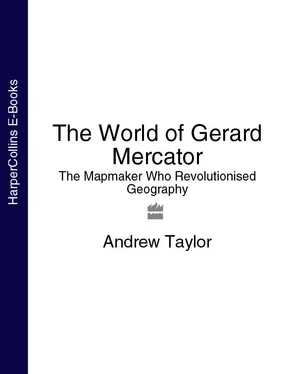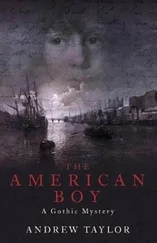In ’s Hertogenbosch, angry crowds rampaged through the narrow streets while Gerard was at school; but the discontent was more often sullen and unspoken. The town had been home to the artist Hieronymus van Aken, better known today as Hieronymus Bosch. 2His wild, tortured depictions of the sufferings of Hell were well known, apparently orthodox enough, and greatly appreciated by the Church authorities – Bosch had painted several altarpieces for the Cathedral of St. Jan in his hometown – but they had a subversive and less conventional secondary meaning. 3Bosch was a reformist, possibly even an out-and-out heretic who saw the Catholic Church as Satan’s embassy on Earth. The evidence is there in Bosch’s works, a telling example of the double-edged, evasive atmosphere of the town where Gerard was growing up.
Many of the symbols in Bosch’s paintings seem now to be consistent with heretical thinking, and his anger over the corruption and avarice of the Church is even clearer. His massive triptych, The Haywain, 4shows a nun cradling the head of a sick or dying beggar in a conventional representation of the Church’s Christian care for the poor. Elsewhere in the same painting, though, other nuns are sweeping the peasants’ crop of hay into their own bags; in another vignette, one of them seems to be making sexual advances toward a musician. The Ship of Fools5 shows a nun and a monk picking over a dish of cherries, a common image of sexual gratification. Seen together, the symbols are unmistakable, but individually they are subtle enough not to offend.
Bosch led a perilous double life, because he was also a leading member in ’s Hertogenbosch of an orthodox and solemn religious fraternity, the Brotherhood of Our Lady. He was a respected figure in the town, as his father and grandfather had been before him, and even took the city’s name for his own. He married a local woman, owned a house, and died. Little else is known about his life, but that is the point: He had avoided attracting attention.
The school Gisbert chose for his young charge in ’s Hertogenbosch revealed the private thoughts behind his own daily life. Like Hieronymus Bosch, he had taken care not to provoke the Church authorities, but the hardworking Gisbert de Cremer had been leading something of a double life as well, building his career within the Church while discreetly supporting the agitation for reform. He handed Gerard over to a religious community known for their reformist zeal, the Brethren of the Common Life.
The Brethren had a long tradition as teachers, but they were not a comfortable institution. For themselves, they had renounced the possession of property and embraced a life of simple obedience; their rule was self-denying and ascetic, and they expected the boys in their care to abide by it as well. One famous former pupil gave a glimpse of the harsh life the pupils could expect: The humanist Erasmus of Rotterdam, who had written his own biting satires on Church corruption, In Praise of Folly and Colloquia, spoke of beatings and bullying at the school by overzealous teachers who wanted to direct their young charges toward the priesthood. His own youthful love of learning had been thrashed out of him for a time by their merciless severity, he said; his time at the school was nothing more than two years lost from his life. “Their chief care, should they see any youth of unusually high spirit and quick disposition ... is to break his spirit and humble him by blows, threats, scoldings, and other devices,” he told a friend. 6

’s Hertogenbosch, from Civitates Orbis Terrarum, 1572
Historic Cities Research Project http://historic-cities.huji.ac.il, The Jewish National and University Library of the Hebrew University of Jerusalem
The Brethren were not monks and took no vows, but they were loyal to the memory of their fourteenth-century founder, Geert Groete, who had drawn crowds with his impassioned preaching against lax ecclesiastical discipline and the corruption of the clergy. They observed a rule of sobriety and chastity that was at least as strict as that in many monasteries. More than a thousand pupils were housed in separate dormitories according to social rank and economic status, ranging from rich to poor. Gerard de Cremer was numbered straightaway among the poor students, making their way each day from the domus pauperum to the school beneath the twisted cathedral gargoyles that Hieronymus Bosch had known so well.
There he encountered the traditional three-branched humanist trivium of grammar, rhetoric, and logic, all of which looked resolutely back toward the certainties and inspiration of the past. Poetry and philosophy came from Homer, Ovid, Plato, Aristotle, and other pagan authors, and theology from Christian divines such as Augustine, Origen, and St. Jerome. Geography, too, came from the distant past: In an age when knowledge of the world was increasing faster than ever before, Gerard and his classmates were pointed sternly toward the learning of Ptolemy and Pliny. All of it was sandwiched between two, sometimes three, daily celebrations of the Mass, and all of it was in Latin. That, not the crudity of workaday Flemish, was the language of the churchman and the scholar.
Among Gerard’s teachers was the grandly named author and playwright Georgius Macropedius – a man already with a dangerous reputation of his own for sympathizing with reformers. Macropedius’s character fitted well with the stern philosophy of the school. In his plays, which were often performed by his pupils for the townsfolk, only the rod and the lash saved boys from willfulness, whoring, theft, and a shameful death on the gallows. To the general approval of the rest of the cast, recalcitrant pupils were soundly whipped until they screamed, and when their mothers tried to intervene, much the same treatment was meted out to them.
That would have been the regime in many schools, at least as far as the pupils were concerned. There was little room for sympathy or consolation. Thus, when news came that Gerard’s mother had followed his father to the grave, the boy had to cope with it on his own. Her death, like that of her husband, did not merit any official record of its cause; death, like sickness, poverty, or disaster, was an ever-present threat. Within the space of two years, Gerard had lost both his parents, and Gisbert’s generosity and his own talents were all he could rely on.
He had clearly fitted in during his time in the ascetic world of the Brethren. Unlike Erasmus, he never complained later in his life of their harshness, and the rules that the Brethren applied to their traditional task of transcribing manuscripts show how diligently he learned their lessons. “You ought to attend in your copying to these things: that you make the letters properly and perfectly, that you copy without error, that you understand the sense of what you are copying, and that you concentrate your wandering mind on the task,” said their rulebook. The art of copying was virtually destroyed by the new flood of printed books by the time Gerard was studying at ’s Hertogenbosch, but as an adult he would become known throughout Europe for the precision of his engraved lettering and his obsession with accuracy, as well as for the single-minded concentration with which he applied himself to his books. He thrived on the traditional emphasis on ancient learning. Ptolemy, introduced to him by the teachers in the cathedral, would remain his scholastic guide and mentor throughout his life.
Gerard also drew some lessons from his great-uncle and from his own earlier life: that the Church had always been a source of support and stability in the confusing world in which he was growing up, and that Gisbert’s prosperity showed the material rewards that could come from not challenging the system openly. The Brethren were always careful to keep the sympathy for the reform movement which they had inherited from their founder within bounds that were acceptable to the Church authorities. In a town where dissent and dangerous opinions were common, Gerard no doubt saw the importance of discretion and the value of security. Inside the walls he had found scholarly disputation and strict discipline, symbolized by the monkish uniform of gray hooded gowns that the boys wore, “after the ancient usage of the Brethren,” but he had also found stability.
Читать дальше













